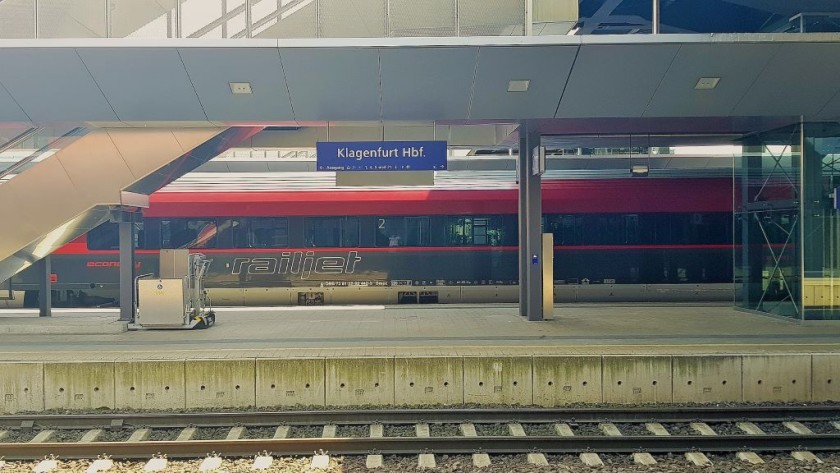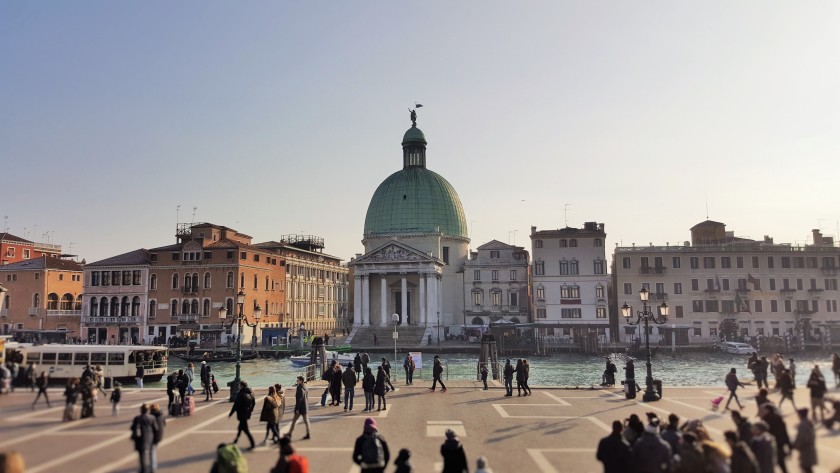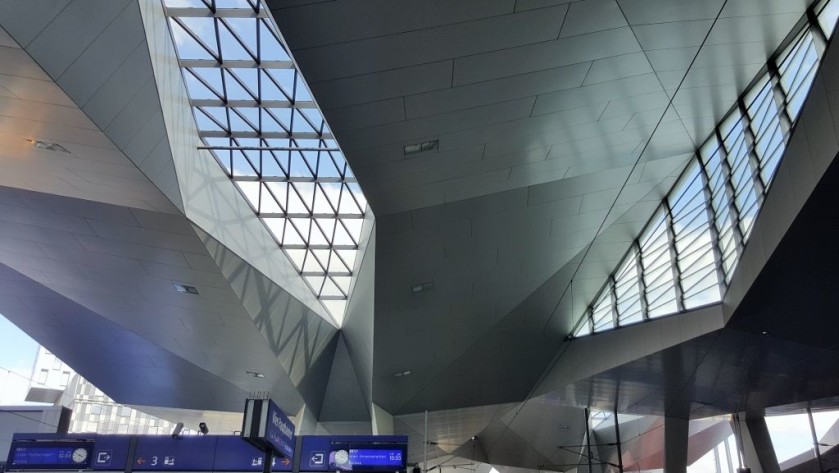Related Content
Content

Wien Hbf/Hauptbahnhof (Wien / Vienna)
This guide to using Vienna's central railway station explains what to look out for when arriving and departing from here by train.
Long distance trains to and from the Austrian capital used to depart from and arrive at multiple different stations.
Now they all use its relatively new main train station - Wien Hbf/Wien Hauptbahnhof.
Share
At a Glance
Services
Left Luggage
Travel Information Desk
First Class Lounge
Local Tourism Information
Onward Travel
Metro
Car Hire
Taxi Rank
Accessibility
Step Free
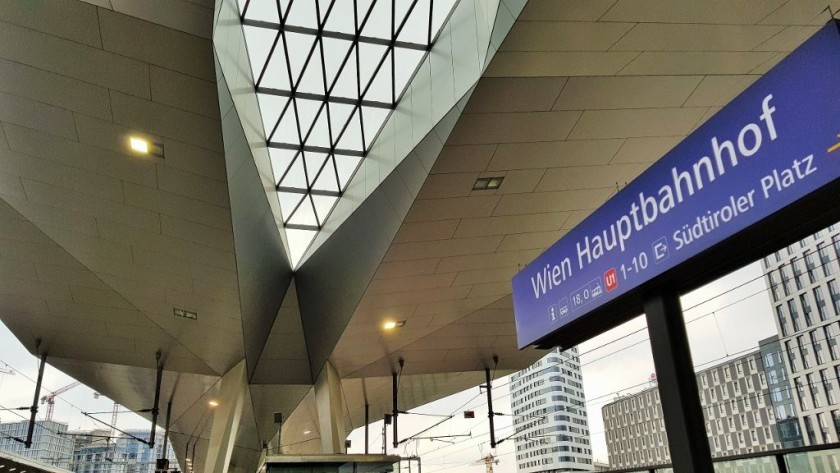





Long distance trains to and from the Austrian capital used to depart from and arrive at multiple different stations. now they all use its relatively new main train station; Wien Hbf/Wien Hauptbahnhof.
The primary reason for an entirely new main station being constructed in the Austrian capital was to exploit the city's role as a Top 3 connectional hub on the European rail network.
Trains head east from Wien/Vienna to Hungary, Romania, Slovakia and they go west to Germany and Switzerland. Trains also head north to Czechia and Poland; and they head south to Croatia, Italy and Slovenia.
Fully opened as recently as 2015 the station has been designed with travelle's front of mind, as all parts of the station have step-free access/
Also the timetable is arranged so that many of the connections between long--distance services simply involve crossing a platform from one train to another.
Though a new main station for Vienna/Wien required a lot of land, hence a location on the the southern edge of the city centre.
The Belverdere Palace and Museum is within a 15 minute walk, but the heart of the city is a three stop ride on Metro line U1; see the info below on how to access the city centre from Wien Hbf.
Good to know:
Seven things worth knowing aout Wien Hbf; the central railway station in Vienna:
(1) All of the platforms/tracks (bahnsteiges) used by the long distance trains have access by lifts (elevators); as well as by escalators and stairs.
(2) The main exit/entrance to the station is on Südtiroler Platz.
It also houses the ticket and reservation office and the OBB 1st class lounge.
The U-bahn (metro) station at Wien Hbf can sometimes be referred to as Südtiroler Platz.
(3) The station has a secondary entrance/exit on Karl Popper StraBe.
It is at the opposite end of the station to the Südtiroler Platz, but some of the tram stops at Wien Hbf are located by this Karl Popper StraBe entrance/exit.
For the western edge of the city centre, the easiest option is usually to take tram line D and this is one of the tram routes, which departs from here.
(4) The station is actually located some distance from the city centre. it's on the southern fringes of the central area.
(5) Wien Hbf is connected to the heart of the city, the area around St Stephens cathedral, by line U1 of the Vienna's metro/underground.
The station at Stephensplatz in the heart of the city is three stops north of Wien Hbf.
(6) The easiest means of accessing the eastern edge of the city centre is to use the
S-bahn (local trains).
They call at Wien Mitte, the main public transport hub in the east end of the city centre.
(7) New, smart, and reasonably priced hotels have opened in the vicinity of Wien Hbf.
So if you want convenient access to and from the station, and are happy to use public transport or taxis to travel to/from the city centre, then staying near Wien Hbf can be a wise choice.




Questions Answered
ShowMeTheJourney has anticipated what questions are most often asked about taking trains to and from Wien Hbf and answered them below.
If you can't find the information you are seeking, you can ask a question and the AI enabled service will try to write an answer, telling you what you wish to know.
Is there step-free access to and from the platforms /tracks?
Yes - all of the platforms / tracks can be accessed by both escalators and lifts / elevators.
How to travel between Wien Hbf and the city centre




The station is actually located some distance from the city centre as it is located on the southern fringes of the central area.
So the optimum mode of onward travel will depend on the final destination in the city:
By metro / subway
Wien Hbf is connected to the heart of the city, the area around St Stephens cathedral, by line U1 of the Vienna's metro/underground.
The station at Stephensplatz in the heart of the city is three stops north of Wien Hbf.
For the Prater amusement park, location of the Wiener Riesenradm ferris wheel, take line U1 (direction Leopoldlau) six stops to 'Pratersen'.
For the Donau City business district take line U1 (direction Leopoldlau) nine stops to 'Kaisermuhlen VIC'.
By local train
The easiest means of accessing the eastern edge of the city centre is to use the S-bahn (local trains). They call at Wien Mitte, the main public transport hub in the east end of the city centre.
By tram
Tram line D from the Karl Popper StraBe exit at the eastern end of the station has direct access to the western edge of the city centre.
It has stops on the inner ring road at Oper, near the opera house and Burgring for the Musuem Quarter and Dr. Karl Renner Ring for the Austrian Parliament building.
Tram line 0 stops outside the main concourse on the Südtiroler Platz, it goes to Wien Mitte station (an alternative to taking the S-Bahn) and Wien Pratersen station (an alternative to taking the Metro line U1)
Tram line 18 has a separate stop that is underground, it's accessed from the passage way which connects the main concourse to the U-Bahn.
It goes to Wien Westbahnhof, take trams heading to Burggasse
How can tickets be purchased for the public transport connections?
Tickets can be purchased from:
- the Wiener Linien info office which is in the entrance hall of the U-Bahn
- from ticket machines in the metro station and at the tram stops
- from ticket machines on the trams
- the Wiener Linien online ticket shop
- you can pay-as-you-go if you download the Wiener Linien app.
A wide range of tickets and passes is available.
How to travel between Wien Hbf and the airport
Wien Hbf is now linked to Vienna Airport/Flughafen by direct trains which generally operate every 30mins during the day.
That's because many of the long distance trains to/from Wien have had their journeys extended to/from Wien Flughafen station.
How to travel to the other main stations in Wien / Vienna
Close to all long-distance trains to and from Wien Hbf also call at Wien Meidling station, so leave or board these trains at that station, if it's location is convenient.
All trains to and from Wien Mitte and Wien Pratersen stations also call at Wien Hbf, except for the CAT airport rail service - but there are direct trains between Wien Hbf and the Wien airport
The transfer between Wien Hbf and Wien Westbahnhof involves making a connection between metro lines U1 and U3 at Stephensplatz - Though many destinations served by trains to and from Wien Westbahnhof also have trains to and from Wien Hbf
Wien-Franz Josef Bahnhof has trains to from multiple destinations not served by trains to/from Wien Hbf, including Ceske Velenice, Gmund, Sigmundsherberg and Krems an der Donau - it is connected to Wien Hbf by tram line / route D.
Are there cafes or restaurants available?
There are more than twenty food / drink outlets in Wien Hbf, those with a full meal service include L'Osteria and the Admiral Sports Bar.
Is there a First Class lounge?

Yes, there is a lounge on level 1 of the main concourse, which can be accessed by a lift / elevator.
It can be accessed by holders of 1st class tickets with a minimum value of €15, plus of holders of multiple cards and passes for 1st class travel, including holders of 1st class Eurail and Interrail passes.
Those with 2nd class tickets with a minimum value of €8 can enter on payment of a €10 fee.
Are there left luggage facilities?
Yes there are lockers which can be accessed during all of the station opening hours, though payment is solely by coins.
Train service summary
Wien / Vienna is among Europe's top tier of cities which are best connected by rail.
The destinations which can be tyoically reached on direct express trains from Wien HBf are:
Austria
- 3 or more x trains per hour = Linz and St Polten
- 2 x trains per hour = Salzburg
- 1 x train per hour = Feldkirch, Graz, Innsbruck, Klagenfurt and Villach
- 1 x train every other hour + 1 night train = Bregenz
- Less frequent = Bad Gastein, Bad Ischl, Hallstat, Kitzbuhel, Lienz and Zell am See
Croatia
- Zagreb = 1 x train per day (connection may be required in Graz)
- Split = up to 1 x train per night (not year round)
Czechia
- Brno and Prague = a minimum of one train every other hour
- Ostrava = 5 x trains per day
France
- Paris via Strasbourg = 1 x night train (3 nights per week)
Germany
- Berlin = 4 x day trains + 2 x night trains
- Dresden = 1 x train per day + 1 x night train
- Frankfurt (Main) = day trains every other hour
- Hamburg and Hannover = 1 x train per day + 1 x night train
- Koln and Bonn and Koblenz = 3 x day trains + 2 x night trains
- Munchen = day trains every other hour + 1 x night train
- Stuttgart = 2 x day trains + 1 x night train
Hungary
- Budapest and Gyor = 1 x train per hour
- Debrecen and Zahony = 2 x trains per day
Italy
- Venice and Udine = 2 x trains per day + 1 x train per night
- Bolzano = 1 x train per day
- Florence, Genoa, La Spezia, Milan and Rome = 1 x train per night
Poland
- Krakow and Katowice and Warsaw = 2 x trains per day + 1 x train per night
- Gdasnk = 1 x train per day
Romania
- Bucharest via Arad and Brasov = 1 x train per night
Slovakia
- Bratislava = 1 or 2 x trains per hour
- Kosice and Zilina = 1 x train per day
Slovenia
- Ljubljana = 1 x train per day
Switzerland
- Zurich = 1 x day train every other hour = 2 x night trains
The Netherlands
- Amsterdam = 1x night train
Ukraine
- Chop = 2 x departures per day
- Lviv and Kyiv = 1 x departure per day
For full details see the journey guides



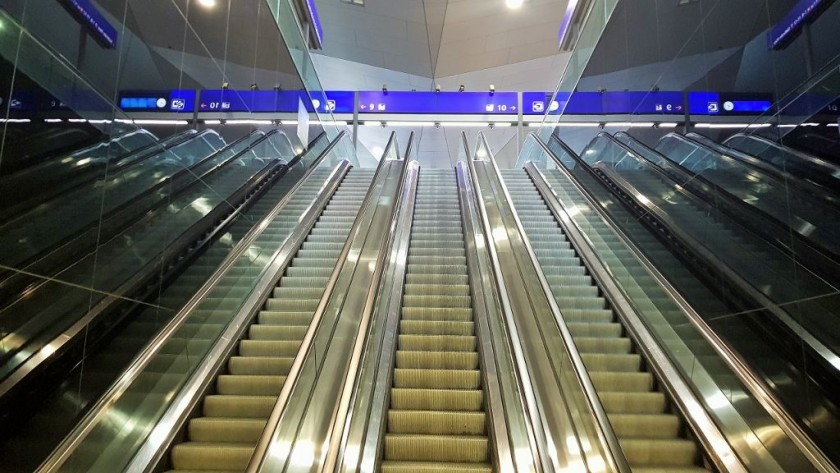
Departing by train:

These five things are particularly worth knowing about taking a train from the main station in the Austrian capital, Wien Hbf (the main station in Vienna).
(1) Being at Wien Hbf at least 10 mins before your train departs is recommended - even if you don’t need to purchase a ticket.
It’s a large station and the exit from the U-Bahn (metro) is some distance from the platforms in the main station (bahnsteige 3 – 12).
So give yourself time to work out which platform/track/bahnsteige your train will be departing from.
If your train isn’t yet listed on the electronic indicators, you can find out where it will (should) be departing from on the yellow departure 'Abfahrt' sheets.
(2) The station is in effect divided into three parts:
- The main station building houses bahnsteige (platforms/tracks) 3 - 12.
All of the international day and night trains use this part of the station as do all of the Railjet express trains to other destinations in Austria.
The bahnsteige (platforms/tracks) in this part of the station are above street level and are linked to the main concourse on Sudtiroler Platz, by a wide passage way, which runs under the railway.
Escalators and elevators link this passage way to the respective pairs of bahnsteige (platforms/tracks)
- Bahnsteige (platforms/tracks) 1 and 2 are below ground level and can be accessed via stairs and escalators and elevators, which are all located on the main concourse.
This part of the station is mainly used by the local 'S-Bahn' trains, including the trains to other stations at the eastern and northern ends of the city centre: Wien-Quartier-Belvedere; Wien-Rennweg and Wien-Mitte and Wien-Pratersen station.
These trains towards the city centre depart from bahnsteig (platform/track) 2.
- The third part of the station is the U-Bahn station on line U1 of the Vienna Metro.
(3) Several trains per hour leave from each bahnsteig (platform/track); so take care when boarding a train.
Check the numerous departure screens to confirm where the next train from each platform (track) will be heading to
(4) Most trains from Wien Hbf don't commence their journeys at Wien Hbf, so they tend to arrive in the station only 2-10 mins before departing.
But if you have a reserved seat you can use the information screens to show you where to wait for easy boarding into the coach in which your seat(s) will be located.
(5) The bahnsteige (platforms/tracks 3-12) are divided into zones, so on each bahnsteige you'll find an electronic display showing which carriage/coach of each train will be in a particular zone when the train is in the station.
So if you have a reservation, or will be travelling 1st class, you can use it to work out where to wait on the bahnsteige (platform/track) for easy boarding.
Zones A-C are at the ends of the bahnsteige (platforms/tracks) closest to the main Sudtiroler Platz concourse.
Using the entrance on Karl Popper StraBe:
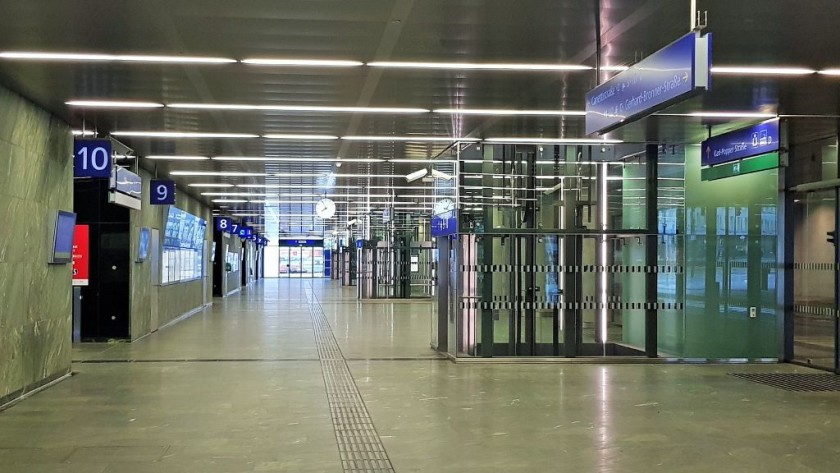
The station has a secondary entrance on a street named Karl Popper StraBe, it is located at the opposite end of the bahnsteige (platforms/tracks) to the main entrance
Unlike the main entrance on Südtiroler Platz, the Karl Popper StraBe entrance only has ticket machines.
If you have arrived at the station by tram line D, this entrance has the most convenient access to the trains.
However, if you're at the Karl Popper StraBe entrance and:
- would rather purchase a ticket from the main ticket office,
- want to make a reservation,
- purchase food/drink etc before boarding your train... then you will have a fairly long walk to access these facilities on the main Südtiroler Platz concourse.




Arriving by train:
The bahnsteigen (platforms/tracks) at Wien Hbf, that the long distance trains arrive at, have two main exits located at either end of the platform.
(1) Head for the exit marked Südtiroler Platz if you want to;
- take a taxi
- transfer to the S-Bahn (local trains)
- take trams on route O and route 18
- take the U-Bahn line U1
The U-bahn line 1 links Wien Hbf to the heart of the city, the area around St Stephen's cathedral.
The Südtiroler Platz exit also leads to the station's main concourse that houses the ticket and reservation office and the OBB 1st class lounge.
(2) Head for the exit marked Karl Popper StraBe if you want to access the city centre by tram line D.
Unlike the U-Bahn line 1, tram line D has direct access to the western edge of the city centre.
It has stops on the inner ring road at Oper, near the opera house and Burgring for the Musuem Quarter and Dr. Karl Renner Ring for the Austrian Parliament building.
The Line D tram stop at Wien Hbf is named ‘Hauptbahnfof Ost’
Accessing other areas of the city centre from Vienna central station:
Lines S1, S2 and S3 of the city’s commuter train (S-Bahn network) all provide a useful link from Wien Hbf to the eastern areas of the city centre.
Take any train from platform/bahnsteig 2 to Rennweg or Mitte stations.
However bahnsteig 2 is some distance from platforms/bahnsteigen 3 – 12 - which are used by the long distance trains.
It is in an underground part of the station - which is accessed via a passage way from the Südtiroler Platz concourse.
Follow the signs to ‘bahnsteige 1 – 2’.
For the Prater amusement park, location of the Wiener Riesenradm ferris wheel, take line U1 (direction Leopoldlau) six stops to 'Pratersen'.
For the Donau City business district take line U1 (direction Leopoldlau) nine stops to 'Kaisermuhlen VIC'.
Book Accommodation
When planning a trip, finding convenient accommodation can be trickier than working out which train to take.
Hence ShowMeTheJourney has partnered with the innovative accommodation portal, Stay 22, to offer three options for discovering your optimum accommodation:
1: Use the map above to see which hotel rooms and Vrbo rentals, with easy access to Wien Hbf, are available.
2: Or click on these cherry-picked properties, offered by Stay 22 partner Booking.com, which are by Wien Hbf and have been selected on the basis of high guest ratings:
Leonardo Hotel Vienna Hauptbahnhof
SMARTments business Wien Hauptbahnhof
Hotel Zeitgeist Vienna Hauptbahnhof
3: Or see what's available with Stay 22's accommodation partners; which include, Expedia, Hotels.com and Trivago - by clicking the large button below.
Stay 22 will 'shuffle' the booking services so that you can be automatically directed to its partner that currently has the optimum availability at this location.
Using Wein Meidling station:
If the start or end point of your journey is adjacent to a station on line U6 of the Vienna Metro, leave or join trains at Wien-Meidling station and NOT Wien Hbf.
All trains to Wien/Vienna from the south and west call first at Wien Meidling, BEFORE they arrive at Wien Hbf.
(So if you're heading for Wien Hbf, take care NOT to leave the train here).
However, if your final destination is on the western and southern edges of the city centre, your best option MAY be to leave the train at Wien-Meidling
It can be worth looking up your final destination in the city - and your onward connection options, before committing to heading for Wien Hbf.
Trains to and from Vienna Airport/Wien Flughafen
Three train services connect Wien/Vienna with its airport:
1: CAT (City Airport Trains) trains that shuttle every 30mins between the airport and Wien Mitte-LandsrtaBe station, which is served by U-Bahn Line U3.
Wien Mitte is on the eastern edge of the city centre.
The journey time between Wien Mitte-LandsrtaBe and the flughafen/airport by CAT train is only 16mins.
The part of the Wien Mitte station used by the CAT trains has check-in desks for many airlines.
You can only use these check-in desks if you take a CAT train to the airport.
2. S-Bahn commuter trains on line S7 also link Wien Mitte station and the airport/flughafen, they're just as frequent as the CAT trains, but are cheaper and slower - but only by 7 minutes!
Also unlike the CAT trains they also call at other stations on the eastern edge of Vienna city centre including Praterstern and Rennweg.
3. Wien Hbf is now linked to Vienna Airport/Flughafen by direct trains which generally operate every 30mins during the day.
That's because many of the long distance trains to/from Wien have had their journeys extended to/from Wien Flughafen station.
So these trains are a good option if the start/end point of your journey is around Wien Hbf, but the CAT or S-Bahn trains are a better option for travelling between the flughafen/airport and Wien city centre.
Railjet express trains also link Vienna Airport direct with stations on the railway lines west towards Salzburg Innsbruck and Bregenz and south towards Graz.
Click the city names below for more info about taking these trains.
City Guides
Not only is Vienna/Wien easy to reach by train from all corners of Europe, the Austrian capital also inevitably offers a wealth of attractions to justify making the journey.
20 Ideas for Experiencing The City (Time Out)
The Most Amazing Experiences in Vienna (Telegraph Travel)
Recommendations From Locals (LikeALocal)
Hidden Vienna (Atlas Obscura)
3 Days In Vienna (Two Scots Abroad)
Insider Tips From A Local (y Travel)
25 Things To Do (Inspired By Maps)
Ideas For A 2 Day Itinerary (Finding The Universe)
Please support ShowMeTheJourney
This second version of ShowMeTheJourney is exciting and new, so we are genuinely thrilled that you are here and reading this, but we also need your help.
We’re striving not to let anything get in the way of providing the most useful service possible, hence a facility has been set up with DonorBox which can be used to support the running costs and make improvements.
Instead of advertising or paywalls, your financial support will make a positive difference to delivering an enhanced service, as there’s a lot of ideas which we want to make happen.
So if you have found the info provided here to be useful, please go here to say thank you.
Journeys
# Jump to a directionJourneys from Wien Hbf/Hauptbahnhof
Jump to directionsWien / Vienna to Amsterdam by train
Wien / Vienna to Berlin by train
Wien / Vienna to Bratislava by train
Wien / Vienna to Bregenz by train
Wien / Vienna to Bruxelles / Brussels by train
Wien / Vienna to București / Bucharest by train
Wien / Vienna to Budapest by train
Wien / Vienna to Dresden by train
Wien / Vienna to Firenze / Florence by train
Wien / Vienna to Frankfurt by train
Wien / Vienna to Graz by train
Wien / Vienna to Győr / Gyor by train
Wien / Vienna to Hallstat by train
Wien / Vienna to Hamburg by train
Wien / Vienna to Hannover by train
Wien / Vienna to Innsbruck by train
Wien / Vienna to Klagenfurt by train
Wien / Vienna to Koblenz by train
Wien / Vienna to Köln / Cologne / Koeln by train
Wien / Vienna to Kraków / Krakow / Cracow by train
Wien / Vienna to Linz by train
Wien / Vienna to Ljubljana by train
Wien / Vienna to London by train
Wien / Vienna to München / Munich by train
Wien / Vienna to Nürnberg / Nuremberg by train
Wien / Vienna to Praha / Prague / Prag by train
Wien / Vienna to Roma / Rome by train
Wien / Vienna to Salzburg by train
Wien / Vienna to Semmering by train
Wien / Vienna to St. Anton by train
Wien / Vienna to Trieste by train
Wien / Vienna to Venezia / Venice / Venedig by train
Wien / Vienna to Villach by train
Wien / Vienna to Warszawa / Warsaw by train
Wien / Vienna to Zagreb by train
Wien / Vienna to Zürich / Zurich by train
Journeys to Wien Hbf/Hauptbahnhof
Jump to directionsAmsterdam to Wien / Vienna by train
Berlin to Wien / Vienna by train
Bruxelles / Brussels to Wien / Vienna by train
Budapest to Wien / Vienna by train
Firenze / Florence to Wien / Vienna by train
Frankfurt to Wien / Vienna by train
Hamburg to Wien / Vienna by train
Innsbruck to Wien / Vienna by train
Köln / Cologne / Koeln to Wien / Vienna by train
London to Wien / Vienna by train
München / Munich to Wien / Vienna by train
Paris to Wien / Vienna by train
Praha / Prague / Prag to Wien / Vienna by train
Roma / Rome to Wien / Vienna by train
Salzburg to Wien / Vienna by train
Venezia / Venice / Venedig to Wien / Vienna by train
Warszawa / Warsaw to Wien / Vienna by train
Zürich / Zurich to Wien / Vienna by train
This second version of ShowMeTheJourney is exciting and new, so we are genuinely thrilled that you are here and reading this, but we also need your help.
We’re striving not to let anything get in the way of providing the most useful service possible, hence a facility has been set up with DonorBox which can be used to support the running costs and make improvements.
Instead of advertising or paywalls, your financial support will make a positive difference to delivering an enhanced service, as there’s a lot of ideas which we want to make happen.
So if you have found the info provided here to be useful, please consider saying thank you.

This is one of more than 100 train travel guides available on ShowMeTheJourney, which will make it easier to take the train journeys you want or need to make. As always, all images were captured on trips taken by ShowMeTheJourney.





















